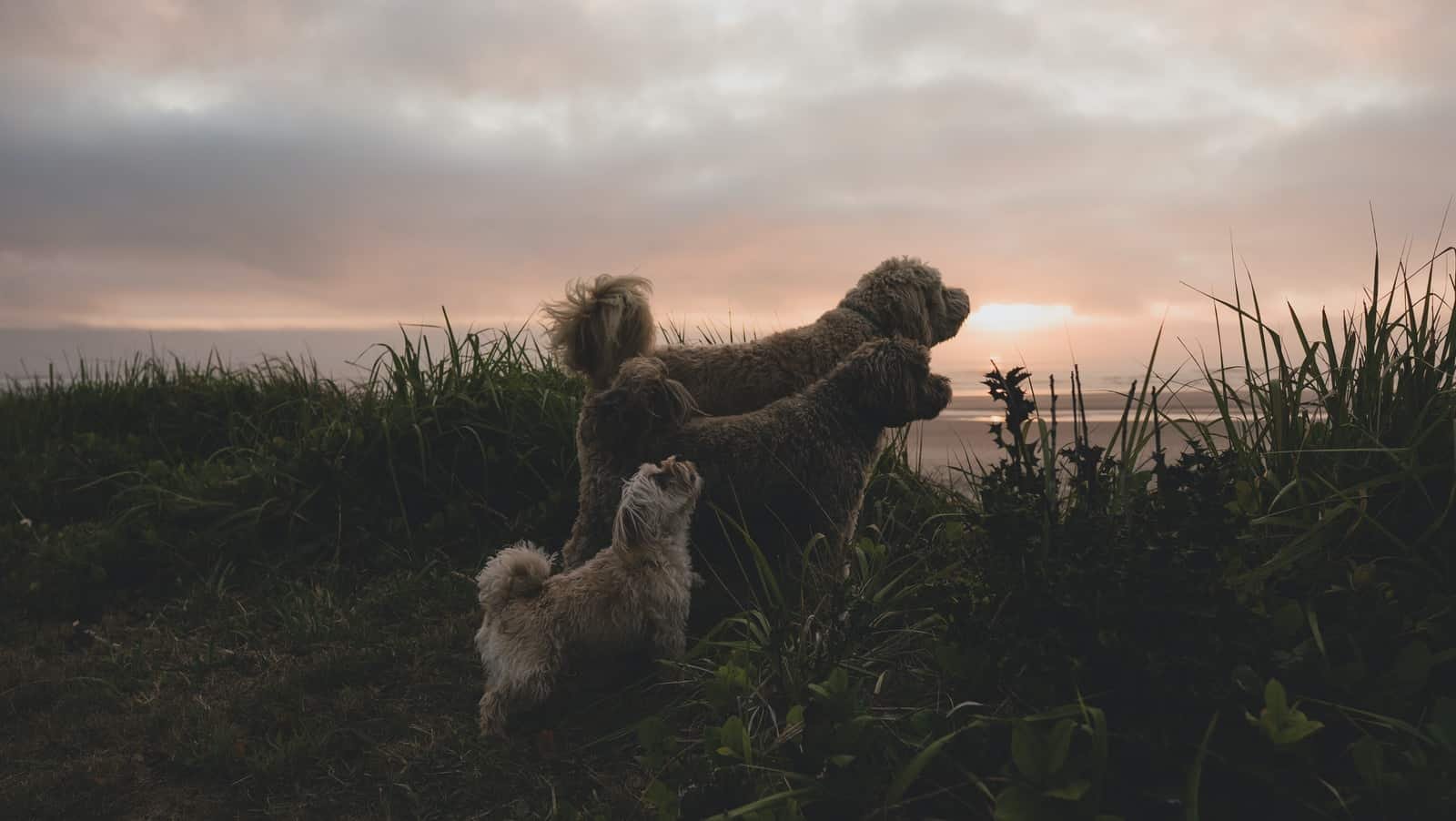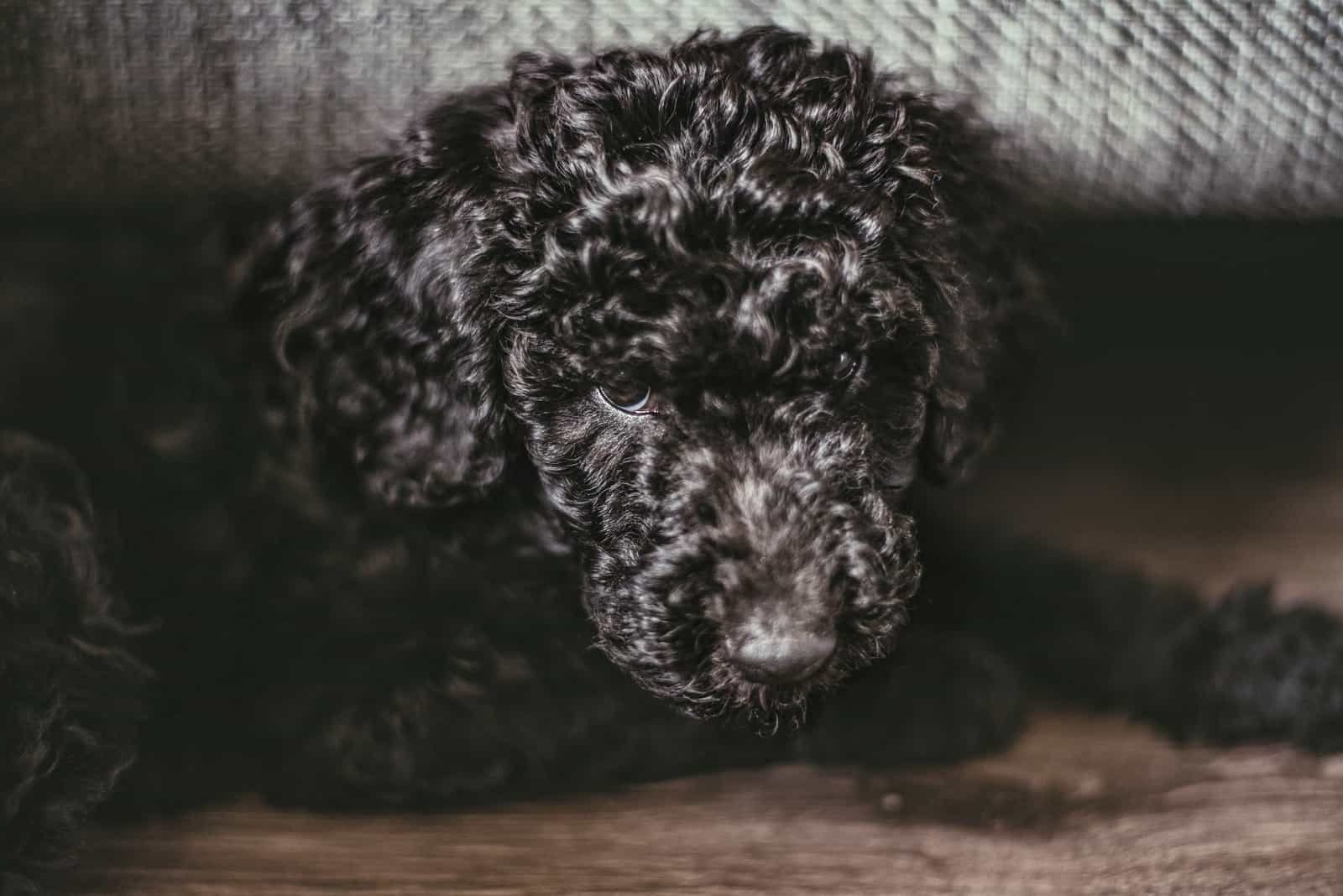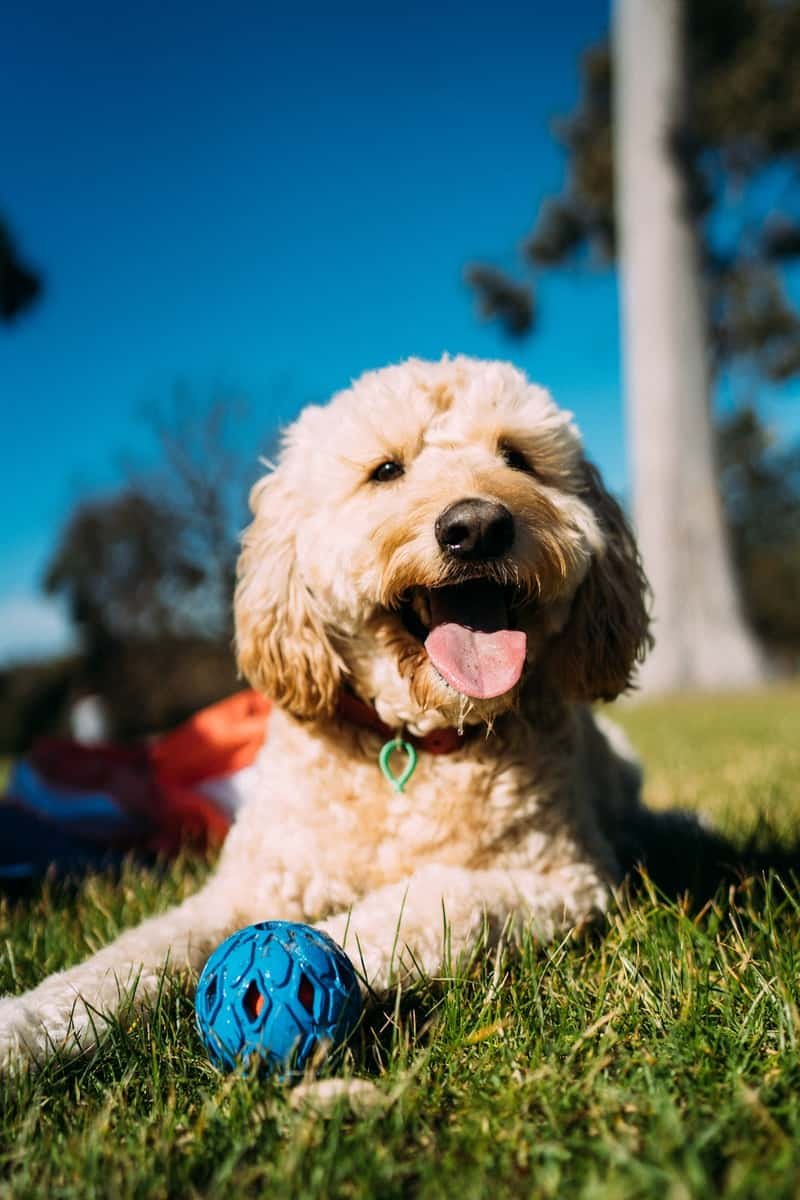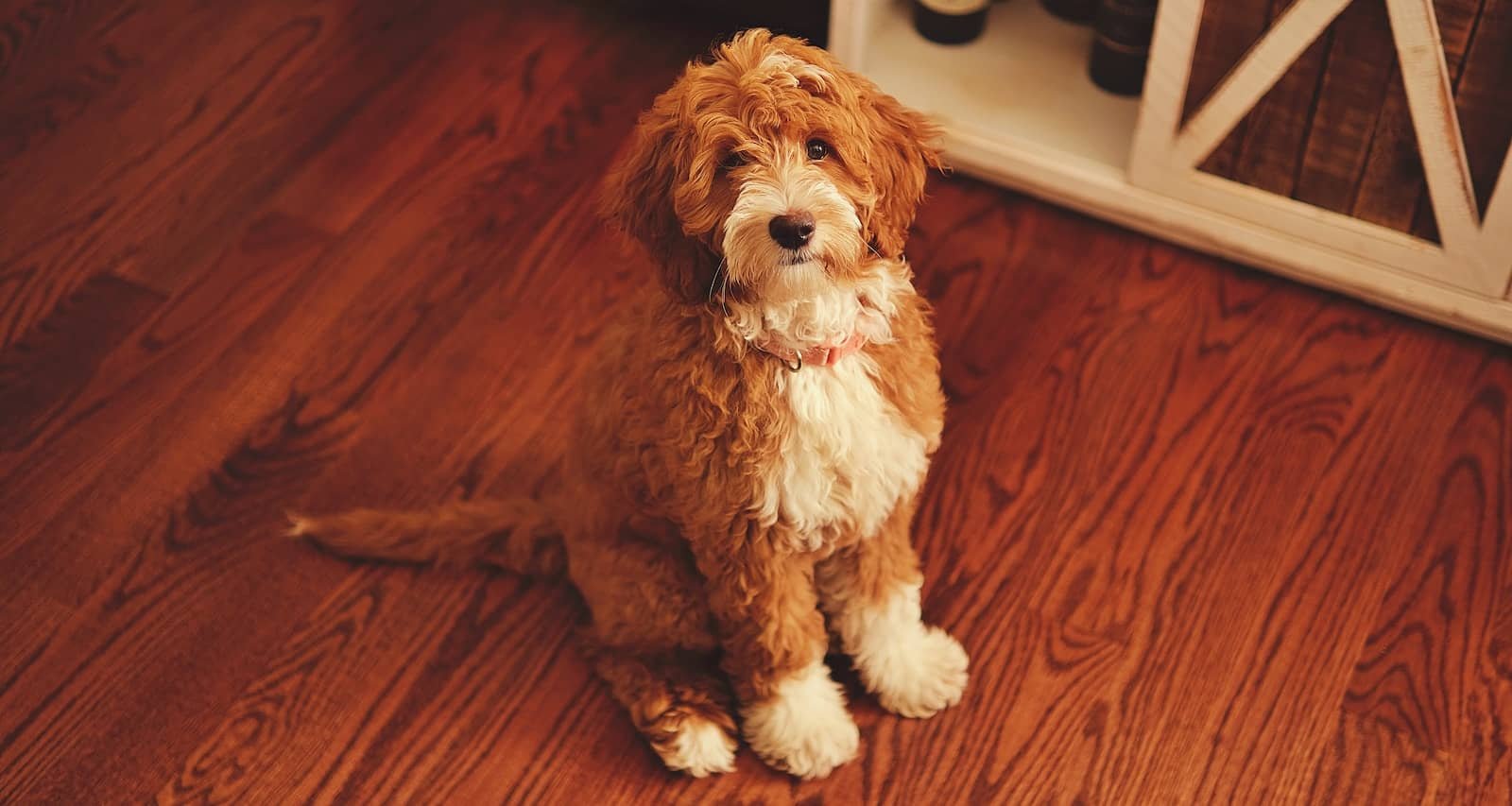
When you’re researching the Newfoundland Poodle Mix, the first thing you’ll probably think of is how they are such gentle giants! Also fondly known as the Newfypoo or Newfoundland Doodle, there’s a reason this mixed breed is stealing hearts.
Read on as we look into the Newfoundland Poodle mix and if they are the ideal family pet for you!
Newfoundland Poodle Parent Breeds
We aren’t familiar with the origins of this designer dog breed, though breeders probably created the Newfy Poodle mix in the 1980s when creating hybrid breeds was popular.
While we aren’t familiar with the origins of the Newfoundland Poodle mix, we see a lot about its parent breeds!
The Poodle originated in Germany as waterfowl retrievers. Hunters admired the breed for its weatherproof, curly coat, natural swimming ability, and intelligence.
Over time, Poodles went from working dogs to living a life of luxury, being the French nobles’ breed of choice. Now, the Poodle is the national dog of France!
As for the Newfoundland, or Newfie, originated as working dogs in Newfoundland for Canadian fishers, hence the breed’s name. From there, Newfoundlands excelled at water rescues thanks to their webbed feet, strength, and swimming ability. Until now, we can find Newfoundlands working as water rescuers.
People then brought Newfoundlands to Europe, where they bred Newfies to spread worldwide.
Newfoundland Poodle Mix Size
The size of a NewfyPoo depends on gender, genetics, and the Poodle parent’s variety. There are three kinds of Poodle varieties based on size:
- Standard Poodle
- Miniature Poodle
- Toy Poodle
That said, NewfyPoos rarely have Toy Poodles as parents, given the size difference between the small breed and Newfoundland.
Miniature NewfyPoos would weigh between 35 to 65 pounds, standing 18 to 21 inches tall.
Standard NewfyPoos are the biggest variety, weighing between 65-120 pounds, standing 22-25 inches tall.
Newfoundland Poodle Mix Appearance
Because Newfoundland and Poodle are not much alike, there will be differences between the cross puppies.
For example, one NewfyPoo puppy would inherit the Poodle parent’s narrow muzzle and curly coat, while another puppy would have big teddy bear-like head from the Newfie. That’s why there are no set standards or uniformity with the NewfyPoo, just like other hybrid breeds. All NewfyPoos have oval-shaped eyes and wide, drooping ears.
When talking about the NewfyPoo’s coat, it’s medium to long. NewfyPoos have a dense coat, either shaggy or curly.
If a NewfyPoo inherits the coat of his Poodle parent, then it will most likely have a hypoallergenic coat. That means your NewfyPoo won’t shed as much, so it won’t cause as many allergic reactions. However, it doesn’t mean a NewfyPoo is entirely hypoallergenic, as some people might be allergic to its saliva, dander, or urine. Before getting a NewfyPoo, it’s essential to hang out with it for a few hours to see if you’re both suitable with one another and that no one in the family has an allergic reaction.
The NewfyPoo comes in a variety of colors, such as
- Black
- White
- Brown
- Red
- Cream
- Silver
- Gray
- Blue
Some NewfyPoos come in single colors, while others are born with two colors.
Newfoundland Poodle Temperament
Like its parent breeds, NewfyPoos have such a big heart! While some people get intimidated by the NewfyPoo’s size, it’s a gentle soul that’s super friendly, intelligent, and lovable.
NewfyPoos have a playful and outgoing nature, so you can expect these dogs to get along with anyone in your family. That said, NewfyPoos are better off in families with older children than younger ones, as NewfyPoos are large and strong, so they can knock over smaller kids and animals!
If you have small children and pets, make sure an adult supervises them during playtime.
NewfyPoos are incredibly loyal to their owners. Some NewfyPoos might be more protective than others, making them suitable watchdogs. Most NewfyPoos are actually quite friendly, to the point are not likely to start fights with intruders.
Like Poodles, NewfyPoos love to take part in all family activities. This mixed breed loves being around its family all day! While that is a dominant trait, it also means the NewfyPoo is susceptible to separation anxiety. If your NewfyPoo is left alone for long periods of time, your dog might have destructive behaviors!
So, do all these characteristics make the NewfyPoo an ideal family pet?
Yes! NewfyPoos are social and friendly, making them ideal family companions. These dogs get along with children and other pets, though you must socialize early to be comfortable with different environments and people.
Also, given their size, NewfyPoos are best suited for families that have houses with yards. Miniature NewfyPoos can live in apartments and smaller spaces if you give them enough daily exercise.
Newfoundland Poodle Regular Exercise and Training
Your NewfyPoo requires regular exercise, but not as much as you’d expect, given their enormous size! 60 minutes of exercise every day is enough for these dogs. Besides walking, you can also try other low-impact activities to get your NewfyPoo moving, such as swimming, playing fetch, jogging, or playing games indoors or in the park and fenced yard.
Avoid heavy exercises that involve high jumping or long periods of running. Such vigorous workouts can harm NewfyPoo’s muscles and joints.
Try leaving dog toys for your NewfyPoo’s mental stimulation if you go away for long periods. That way, your NewfyPoo won’t take out his boredom and frustration with your furniture!
Regarding NewfyPoo’s training requirements, consider training your dog daily, just like exercise. 10-15 minutes of daily training will mentally stimulate your NewfyPoo, who’s intelligent and loves to learn! Just make sure you conduct positive reinforcement training rather than scream or act harshly, which won’t do anything but scare your dog.
Besides that, start training your NewfyPoo while he’s still a puppy. If you wait too long, then your dog may have behavioral issues. Here are the training you should conduct:
- Socialization
- Housetraining
- Crate training
- Leash training
- Obedience training
- Agility training
If you’re new to training dogs, you can always take your NewfyPoo to puppy classes or learn from online training courses.
Newfoundland Poodle Health Issues
NewfyPoos have a lifespan of 8-12 years. While a mixed breed would have hybrid vigor, NewfyPoos are still at risk of potential health concerns.
Here are the potential health concerns to look into:
- Eye conditions like retinal atrophy
- Canine hip dysplasia
- Gastric dilation volvulus
- Patellar luxation
- Elbow dysplasia
- Heart conditions like subvalvular aortic stenosis
- Thyroid disorders
Whether your dog has major or minor health concerns, it’s essential to have it checked by the veterinarian. Make sure your NewfyPoo has regular check-ups and consider getting health tests to know what your NewfyPoo is at risk of in the future.
Newfoundland Food Requirements
Given their size, expect the NewfyPoo to be a heavy eater! When choosing dog food for your NewfyPoo’s diet, it should be made of natural, high-quality ingredients planned for your large-sized dog. Select dog food formulated for your dog’s specific age and activity level.
If you have questions or your dog has certain health conditions, it’s best to consult the veterinarian for specific brands and types of dog food. The vet can recommend the best diet for your dog and in proper amounts.
NewfyPoos will require 4-6 cups of dry food daily, divided into smaller meals. Monitor how much dog food you give your NewfyPoo to prevent it from gaining too much weight.
Newfoundland Poodle Grooming Requirements
While most NewfyPoos have a low-shedding coat, they still have high grooming requirements, like the Poodle.
However, the amount of grooming you provide to your dog will depend on the type of coat he inherits.
There are three kinds of coats your Newfoundland Poodle will most likely inherit.
Wool Coat
Dogs with dense wool coats won’t shed, though combining will be challenging. We propose brushing your dog’s coat 2-3 times a week.
The wool coat has a slower growth rate, so your dog won’t need haircuts as frequently.
Hair Coat
Hair coats are easiest to manage among the other types and won’t shed as much. We propose brushing your NewfyPoo every other day with a soft brush to help your dog’s natural oils circulate evenly throughout his coat.
Fleece Coat
Fleece coats are high maintenance. Dogs with these coats won’t shed as much and feel soft, but you’ll need to brush them every day with a slicker brush.
Regardless of the coat type your NewfyPoo has, you will need to bathe him once a month with premium dog shampoo and conditioner. You need to check your dog’s eyes and ears weekly, trimming and cleaning these sensitive areas as required.
NewfyPoos are prone to dental issues, requiring regular toothbrushing at least 2-3 times a week.
If you can’t bathe your dog or give him a haircut, you can always take him. to a professional groomer. It may set you back $50-$100 monthly, but at least you’re assured a completely clean and well-trimmed dog.
How Much is the Newfoundland Poodle Mix?
The price of a NewfyPoo will vary, depending on the breeder, your location, demand, and the parent breeds. Prices will range between $500-$2,000, but most breeders sell their NewfyPoos for $1,000-$1,500.
You can find a reputable breeder online and ask the local dog or mixed breed clubs for recommendations. Your community’s local veterinarian or neighbors who own NewfyPoos may also give you names of good breeders to work with. Once you have found a few breeders in your area, research their reputation and ask them about the required certifications, health tests, and other documents related to their dogs.
Never go to puppy mills! Even if these “breeders” sell their puppies at such low prices, they most likely raise animals inhumane conditions. Dogs from such breeders have higher risks of health issues in the long run.
Alternatively, you can always adopt. Your local shelters may have NewfyPoos up for adoption and at a lower price. However, you’ll most likely adopt an adult NewfyPoo with little knowledge of its medical records. That said, you can always conduct health tests on your adopted dog to find out more about his condition and what’s needed to care for it better.





